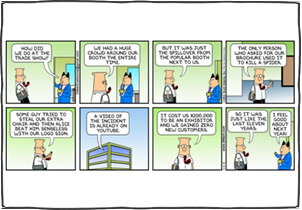
When it comes to Account Based Marketing, the Event and Conference Industry, is like other B2B sectors. Few players have taken the plunge into using ABM for attendee marketing. That’s a mistake. ABM, is a simple but powerful idea that offers compelling benefits to Event Marketers. ABM can reduce marketing spend, generate better quality leads, improve conversion, and exceed your targets.
So what’s holding up the adoption of ABM? According to a survey, by one of the ABM software platform companies, the top 4 reasons for not using ABM are: lack of knowledge on how to get started; absence of technology for automating; insufficient time due to other marketing priorities; and doubts about benefits of ABM.
The good news is that these hurdles can easily be overcome. Unless you are managing hundreds of events, you can get by without additional IT investment. ABM is really about refocusing marketing, not learning new marketing techniques. So you already know most of what you need to get started. And best way to be sure of its benefits is to pilot a campaign or two.
So how would you go around launching ABM? The best way to illustrate is to consider a hypothetical case study. Let’s say you are responsible for CMB 2016, the hottest Content Marketing conference. Your goal is to increase attendance from 2,000 to 2,500 this year. So let’s walk through the ABM approach step-by-step.
First you need to build a simple model to split the target into renewal from prior year attendees and recruitment of new attendees. You need to factor in historical attendee churn to do so. Let’s say you did that and the targets are 1,800 renewals and 700 new attendees. ABM can be used for both renewals and new acquisitions. But in this blog we will just focus on the new attendee recruitment. We will also side step the fact that new attendees can come from existing Accounts. So our goal is to get 700 new attendees from brand new accounts.
The next step is to create a list of Accounts to target. This is one of the most critical steps and it is important to get it right. B2B industry databases are not very useful since they have stale, canned information. You will need to do primary research to develop these accounts. There are number of techniques you can use. You can find target Accounts by researching competitors of past attendees. This works well for large enterprises but is hard to do for small and medium enterprises. You can find companies by searching relevant titles in LinkedIn (e.g director of content marketing). There are other ways to build this list.
Now you need to find the right prospects within those Accounts. If the goal is 700 new attendees, depending on conversion rate, you may need 8,000 to 10,000 leads. This may sound like a lot of work but is well worth the investment in time and effort. The traditional approach of finding leads using the Title filter in B2B databases will give poor quality leads. Titles are often not a good proxy for roles and the responsibilities. In a small enterprise, for instance, the CEO could very well be the person that you want to target. A tele-survey is the quickest way to develop a high-quality contact list.
The final step is to create holistic view of the contact information for the prospects in each Account. Compiling accurate email address, working telephone number, and current postal address is a good start – but not sufficient anymore. You also need social Identifiers – particularly LinkedIn and Twitter. They will help connect with them socially and also monitor their social activity.
You have now completed probably the most difficult phase of ABM. Now you need to create an integrated marketing campaign – that uses direct response and digital techniques – to target these prospects and generate high-quality leads for your sales. This is the topic of our next blog.

Focus marketing, improve response rates, optimize marketing expenses, and generate highly targeted leads with Account Based Marketing.

Enrich CRM with Social Media Intelligence and reverse data quality decay

Unleash the power of Social Media channels for effective B2B marketing for event marketing, subscription management, lead generation, and other such campaigns.